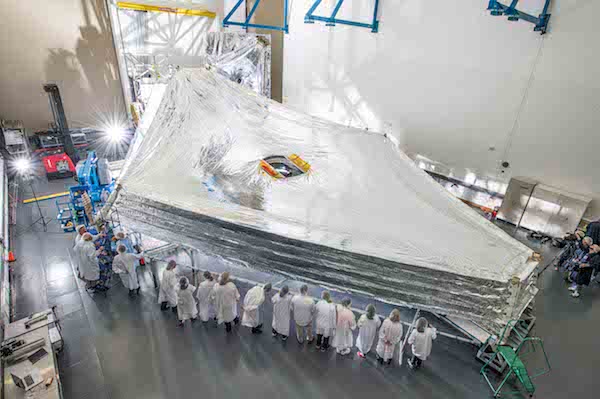Looking Up: Space is hard

The sunshield of the James Webb space telescope undergoes testing in California.
February 13, 2017
Look up to the stars, everyone! Senior Aileen Zhang’s column “Looking up” is about breakthroughs, cool facts and ethics in modern science, especially astronomy. This week she discusses the obstacles in space exploration.
Above the thin shroud of our terran atmosphere, outer space looms deadly, dark, and empty. But our curiosity for the great unknown pushes us to send probes and people away from our well-plumbed and air-conditioned home planet and into the unfamiliar and unfriendly reaches of space.
Space is teeming with gamma rays, X-rays, and heavy ions from the sun and other cosmic sources. For us, this high-energy radiation causes cancer and cell death. (Many Apollo astronauts reported seeing flashes of light perhaps caused by heavy ions passing through their retinas.) Electronic equipment is also degraded by high energy radiation, causing signal noise and glitches in the short run and decreased instrument functionality over time. To protect against radiation, spacecraft are wrapped in layers of insulating material and undergo radiation hardening. For example, satellite computers are constructed using microchips of silicon on sapphire instead of the usual semiconductor wafer. But even with insulating materials, spacecraft experience much more radiation than earth-based instruments. An astronaut on the International Space Station experiences radiation levels almost a hundred times greater than a person on earth.
https://www.instagram.com/p/BFUCckGM2Jk/?taken-by=astro_timpeake
This chip in the ISS cupola is about a centimeter across, but it was created by debris a fraction of a millimeter wide. (Tim Peake)
Not all space dangers are natural. In low-earth orbit, shards of debris from exploded satellites and other bits of trash pepper the paths of functioning satellites and the International Space Station. Because of its high velocity, a tiny projectile can cause enormous damage. Just recently, the International Space Station got hit by a fleck of paint a fraction of a millimeter wide, resulting in an alarming crack in an observation window. Even with quadruple-layered glass and aluminum debris shields, the ISS is still vulnerable to space junk as small as ten centimeters wide. Furthermore, the effects of space debris are multiplicative; a chunk of debris might shatter a satellite, creating millions more pieces of dangerous trash.
Space protection extends beyond shielding people and equipment from physical harm. The James Webb space telescope uses giant sunshields to preserve ideal conditions for observation of low-energy infrared wavelengths. To keep the telescope at a chilly 7 Kelvins (-447° Fahrenheit), a five-layer reflective shield the size of a tennis court protects against temperature fluctuations and the glare of the sun.
On Earth, we are lucky enough to have several miles of air between our fragile bodies and outer space. Still, some dangers remain, most notably a portion of the sun’s UV rays that pierce the atmosphere and reach the ground, even in cloudy weather. Exposure to this radiation significantly increases the risk of skin cancer, the most common cancer in the United States.
Space is hard. Space is dangerous. The least we could do on Earth is put on sunblock — preventing UV exposure is the best way to lower one’s risk of developing skin cancer. Compared to wearing aluminum blinds or living in a spacesuit, that’s no trouble at all. So, if you anticipate spending any time outside, slather on some sunscreen. Satellites never go without it; neither should you.



